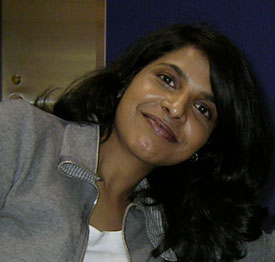By Karthika Swamy Cohen
The collective “whoa” from everyone in the room said it all. With his coin “magic” trick, Tim Chartier not only captured the attention of the 50 high schoolers gathered at Manhattan’s High School of Economics and Finance early in the morning on their first day of spring break, but also indelibly linked the power of math to activities they had so far never associated with the subject. Not to mention, earned them bragging rights among friends for a long time to come.
Chartier, a mathematics professor at Davidson College, proceeded to explain the “magic,” a trick built upon a method of counting coins in an unusual way. “Math makes the magical logical,” he said. Describing the mathematical curve that forms when launching a bird on Angry Birds, the mathematical underpinnings of movie special effects, and the math behind improving a sports team’s performance, Chartier spoke the teenagers’ language while simultaneously opening their eyes to a world of possibilities with mathematics.
“Sometimes kids can be good at math but they’re not always sure why they’re learning it, so there can be a motivational gap between math and their actual learning,” said Chartier. “One of the things we are doing today is helping kids see why they should be learning math.”
After hearing all about mathematical applications in everyday problems, the students were ready to put this information into action. Katie Fowler of Clarkson University led a mathematical modeling workshop with a real-world problem: how many cats would result from the breeding of two cats over several years?
Presenting vastly different answers to this question from various animal humane societies, Fowler illustrated the need for help in the area, reinforcing the open-ended nature of mathematical modeling. “The problem of trying to understand the stray cat population can be approached on many different levels,” Fowler explained. “Different groups of students will come up with very different numbers, but they’ll be able to justify that based on the assumptions they make. They’ll see that there is more than one way to get an answer to a problem.”
Fowler explained the various components of the modeling process to the group: defining the problem statement, making assumptions, assigning variables, creating a model, and validating the model with real data. She then asked students to consider the multiple factors that could influence cat populations. Participants came up with relevant considerations, including the number of male versus female cats, mating age and times, litter sizes, the length of pregnancies, and so on. After a preliminary discussion, students split in groups to work on their math models.
The objective of the Moody’s Mega Math Workshop, an outreach initiative by The Moody’s Foundation and SIAM, was to help students connect math to real-world issues. “I really enjoyed the workshop because it showed me how math is a part of our everyday lives, which you don’t get to see a lot,” said Destiny Santos-Ferrer of New Design High School. “We usually don’t see how math connects to the real world and how it’s used in multiple jobs and careers. [This workshop] incorporated what we are learning in different ways and made us more appreciative of math.”
The final speaker of the day was Lindsay Hall, a software engineer at Google. After sharing her personal experiences with math and computer science in high school, Hall described the many ways she uses math at Google. She gave students a chance to ask her questions about Google products of interest to them, and proceeded to explain the underlying math in each – such as finding directions using Google Maps as a graph problem where the map calculates the shortest way to get from one “node” to another.
The workshop concluded with awards of $1,000 each in college scholarships to three random winners. The recipients, Naiomy Rangel of the High School of Economics and Finance, Maurice Avery Jr. of Marta Valle High School, and Chelsea Vicente of Queens Vocational and Technical High School, were also recognized at the Moody’s Mega Math Challenge awards reception at Moody’s Corporation headquarters and treated to a trip to the New York Stock Exchange to witness the Closing Bell ceremony.
“There’s not nearly enough extracurricular mathematics in New York City, so we have a number of students who are always hungry for more math and some kind of challenge,” said Dr. Philip Dituri, who accompanied his students to the workshop from New Design High School. “A lot of times students do modeling without being completely aware that they are modeling. Every time a kid answers a word problem in an algebra class, they model a real life situation with algebra, but they are not entirely aware that it is a modeling activity. I think this workshop gave them a real-world perspective.”
 |
Karthika Swamy Cohen is the managing editor of SIAM News. |